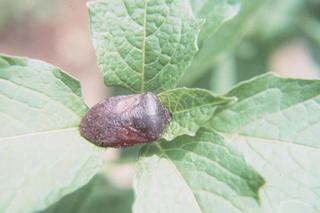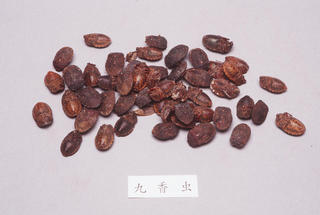Aspongopus chinensis
Contents
Nomenclature
Other Names:
Historical Use of Aspongopus chinensis
Aspongopus chinensis in Traditional Chinese Medicine
Background
Chinese Name (pinyin): Jiuxiangchong
Chinese Name :
Common Name :Jiuxiang bug
Specific Name : Aspongopus
Scientific Name:
Collection : The drug is collected from November to the next March, place in an appropriate container, suffocated with wine, taken out and dried in the shade, or scalded to death in boiling water, taken out and dried.
Description : Somewhat hexagonal and flattened ellipsoidal, 1.6 - 2cm wide. The surface is brown or brownish-black, slightly lustrous. The head small, head thorax slightly triangular, compound eyes, avoid a pair of single eyes, a pair of antenae each with five segments, usually dropped. The dorsal part of the thorax bearing two pairs of wings, the basal part of the outer pair relatively hard, the inner pair membranous and transparent. The thorax bearing 3 pairs of legs, usually dropped. The abdomen is brownish-red to brownish-black, each segment with projected small points close to the margin. Texture: fragile, pale brown contents in abdomen visible when broken, odor: characteristic, taste: slightly salty.
Identification :
Processing : Aspongopus eliminate foreign matter.Aspongopus (stir-fried) stir fry clean aspongopus as describe under the method of simple stir frying (Appendix llD) until aromatic odor is produced.
Action : To regulate the flow of qi and relieve pain, to warm the stomach, and to restore the kidney yang.
Indication : epigastric pain with distension due to cold in the stomach or due to stagnation of qi in the liver and stomach, impotence and aching of the loins and knees in deficiency syndromes of kidney
Precautions :
Dosage : 3 to 9 g.
Storage : Preserve in wood boxes lined with wax paper, protected from moisture and moth.
Synonymns for Aspongopus chinensis
Patent Medicines and Medicines with Multiple Ingredients that include Aspongopus chinensis
Pharmaceutical Information
Chemical Constituents
Evidence or the Use of Aspongopus chinensis in the Treatment of Epilepesy
Basic Science
Animal Studies
Cohort, Case-Control and Non-Randomized Trials
Randomized Controlled Trials
Meta-Analysis
1st Five Results: pubmed search
Renlian Cai, Xumei Chen, Samiullah Khan, Haiyin Li, Jun Tan, Ying Tian, Shuai Zhao, Zhiyong Yin, Daochao Jin, Jianjun Guo
##Title##
Heliyon: 2024, 10(6);e27525
[PubMed:38500987]
[WorldCat.org]
[DOI]
(P e)
Renlian Cai, Samiullah Khan, Xumei Chen, Haiyin Li, Jun Tan, Ying Tian, Shuai Zhao, Zhiyong Yin, Tongxian Liu, Daochao Jin, Jianjun Guo
Aspongopus chinensis ach-miR-276a-3p induces breast cancer cell cycle arrest by targeting APPL2 to regulate the CDK2-Rb-E2F1 signaling pathway.
Toxicol Appl Pharmacol: 2024, 484;116877
[PubMed:38431228]
[WorldCat.org]
[DOI]
(I p)
Xinyi Ma, Zhiyong Yin, Haiyin Li, Jianjun Guo
##Title##
Bull Entomol Res: 2024;1-11
[PubMed:38425077]
[WorldCat.org]
[DOI]
(I a)
Yong-Ming Yan, Ji-Jun Li, Yong-Xian Cheng
##Title##
Org Lett: 2024, 26(7);1506-1510
[PubMed:38345436]
[WorldCat.org]
[DOI]
(I p)
Yong-Ming Yan, Xing-Hui Bao, Ji-Jun Li, Yan-Peng Li, Hao-Xing Zhang, Yong-Xian Cheng
##Title##
J Agric Food Chem: 2023, 71(51);20690-20700
[PubMed:38100375]
[WorldCat.org]
[DOI]
(I p)

